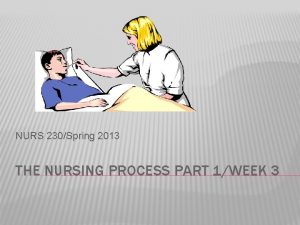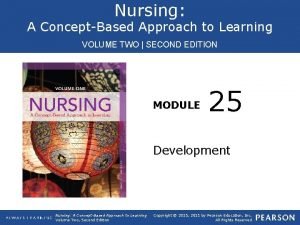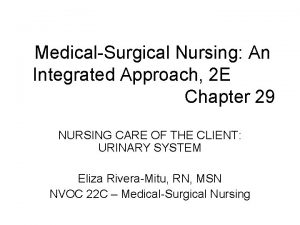MedicalSurgical Nursing An Integrated Approach 2 E Chapter
















- Slides: 16

Medical-Surgical Nursing: An Integrated Approach, 2 E Chapter 11 IV Therapy

IV Therapy n Administration of fluids, electrolytes, nutrients or medications by the venous route.

Parenteral Fluids Hypotonic Fluids – lowers the osmotic pressure and causes fluid to move into cells n Isotonic Fluids – increases extracellular fluid volume n Hypertonic Fluids – increases osmotic pressure, drawing fluid from cells n

Equipment Needed n n IV Filters – remove particulate matter from solutions Needles & Catheters – provide access to venous system Peripheral IV & Heparin locks – establish a nenous route in those clients whose condition may change rapidly Vascular Access Devices – allow long-term IV therapy

Preparing a Solution Review agency policies n Verify the expiration dates n

Initiating IV Therapy Use the shortest needle and smallest gauge n Consider the client’s age, health and skin condition n In general, begin with the hand move up the arm n

Locating a Vein Place a tourniquet on patient’s arm n Palpate for vein with index and middle finger of non-dominate hand n

Placing the Needle Prepare selected site according to institution standards n Hold the needle at a 10 -30 degree angle n

Administering Flow-Rate Flow Rate must be calculated n Period of administration may vary n

Calculating Flow Rate Total Volume = m. L/hour infusion rate Hours of Infusion For example: 1000 m. L 8 Hours = 125 m. L/hour infusion rate

Managing IV Therapy requires constant monitoring n Concerns may be: n Hypervolemia (increased fluid volume) n Infiltration (seepage of foreign substances) n Phlebitis n

IV Drug Therapy The IV route is used when a rapid effect is desired n An immediate impact may be realized n

Methods of IV Drug Therapy Intravenous fluid container n Volume-control administration set n Intermittent infusion by piggyback or partial fill n IV push or bolus n

Blood Transfusions Designed to replace blood loss with whole blood or blood components n Used to restore blood volume after severe hemorage n

Whole Blood n Contains red blood cells (RBCs) and plasma

Administering Blood Follow institution guidelines n Verify consent form n Watch for reactions: n Allergic n Febrile n Hemolytic n
 An integrated approach to business studies
An integrated approach to business studies Lone star college nursing program requirements
Lone star college nursing program requirements Integrated nursing pathway
Integrated nursing pathway Diff between virtual circuit and datagram network
Diff between virtual circuit and datagram network Theoretical models of counseling
Theoretical models of counseling Waterfall vs shower approach
Waterfall vs shower approach Multiple conflict
Multiple conflict Bandura's reciprocal determinism
Bandura's reciprocal determinism What is research approach definition
What is research approach definition Diagram for traditional approach
Diagram for traditional approach Tony wagner's seven survival skills
Tony wagner's seven survival skills The nursing process organizes your approach
The nursing process organizes your approach Chapter 16 nursing assessment
Chapter 16 nursing assessment Nursing a concept based approach to learning volume 2
Nursing a concept based approach to learning volume 2 Nursing a concept based approach to learning
Nursing a concept based approach to learning Nursing a concept based approach to learning
Nursing a concept based approach to learning Functional nursing model
Functional nursing model































